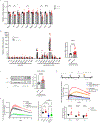The antipsychotic drug thiothixene stimulates macrophages to clear pathogenic cells by inducing arginase 1 and continual efferocytosis
- PMID: 40198748
- PMCID: PMC12068545
- DOI: 10.1126/scisignal.ads6584
The antipsychotic drug thiothixene stimulates macrophages to clear pathogenic cells by inducing arginase 1 and continual efferocytosis
Abstract
Stimulating efferocytosis, the phagocytic removal of apoptotic cells by macrophages, has been proposed as a method to eliminate dying or dead cells that accumulate and contribute to diseases such as cancer, atherosclerosis, and infection. Toxicity related to the off-target clearance of healthy tissue has led to the premature termination of multiple clinical programs for proefferocytic therapies. To identify potential proefferocytic therapies with established risk profiles, we screened ~3000 US Food and Drug Administration (FDA)-approved drugs and other well-characterized compounds for their capacity to stimulate efferocytosis. We found that the antipsychotic drug thiothixene stimulated efferocytosis of apoptotic and lipid-laden cells by mouse and human macrophages and enhanced the continual efferocytosis of apoptotic cells. Consistent with thiothixene's suppressive effects on dopaminergic signaling, dopamine potently inhibited efferocytosis in a manner that was only partially reversed by thiothixene. The prophagocytic effects of thiothixene in mouse macrophages depended on increased expression of the gene encoding the retinol-binding protein receptor Stra6L, which, in turn, promoted the production of the continual efferocytosis stimulator arginase 1. Our findings demonstrate that dopamine inhibits efferocytosis in macrophages and identify thiothixene, a generic, FDA-approved antipsychotic drug that has been in use for more than 50 years, as a promising candidate for promoting continual efferocytosis and the removal of diseased tissue.
Conflict of interest statement
Completing Interests:
The authors declare that they have no competing interests.
Figures





References
MeSH terms
Substances
Grants and funding
LinkOut - more resources
Full Text Sources
Research Materials

